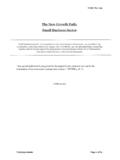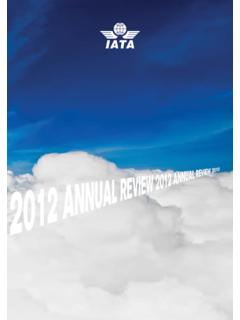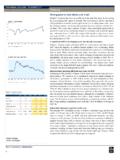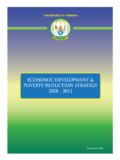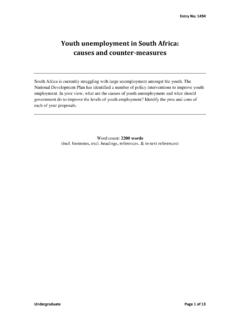Transcription of chap 2 - 120218 - treasury.gov.za
1 2. Economic overview In brief Gross domestic product growth of 1 per cent is expected for 2017, up from per cent projected in October 2017. Growth is forecast to reach per cent by 2020. The economy has benefited from strong growth in agriculture, higher commodity prices and, in recent months, improving investor sentiment. The global economic recovery provides a supportive environment for South Africa to expand trade and investment, but domestic constraints that have reduced business confidence stand in the way of accelerated growth. In 2017, gross fixed-capital formation continued to decline and unemployment reached the highest level recorded since 2003. To boost capital expenditure and job creation, the upturn in confidence will have to be sustained. Government will implement structural reforms to promote investment by reducing policy uncertainty, and act decisively to strengthen governance and sound financial practices at state-owned companies.
2 Overview S. outh Africa's economic growth outlook has improved in recent South Africa's economic months, following a year marked by recession and policy outlook has improved, with uncertainty. GDP growth of 1 per cent is expected for 2017, up from GDP growth of per cent per cent projected in the 2017 Medium Term budget Policy Statement projected in 2020. (MTBPS), and is forecast to reach per cent by 2020. The improved outlook flows from strong growth in agriculture, higher commodity prices and an incipient recovery in investor sentiment. Although global risk factors remain elevated, the world economy continues to provide a supportive platform for South Africa to expand trade and investment. World economic growth is at its highest level since 2014 and continues to gather pace. GDP growth is rising across all major economies. The International Monetary Fund (IMF) forecasts global growth of per cent in 2017 and per cent in 2018.
3 13. 2018 budget REVIEW. South Africa has To create large numbers of jobs , build an inclusive and transformed underperformed relative to economy and reduce inequality, South Africa needs a strong, sustained peer countries expansion. Yet in contrast to many of its developing-country peers, South Africa has experienced a period of protracted economic weakness, mainly as a result of domestic constraints. This is reflected in low levels of private investment, persistently high and rising unemployment, and declining real per capita income. These factors in turn have undermined the sustainability of the public finances and narrowed the scope for economic transformation. Figure Investment and business confidence Figure GDP and unemployment Private investment Business confidence (right axis) Real GDP Unemployment rate (right axis). 15 6 28. 80. 10 5. 70. 4 27. 5. 60. 3. (50=neutral).
4 Per cent Per cent Per cent 0. 50. Index 2 25. -5 40 1. -10 30 0 24. -15 20 -1. -20 10 -2 22. 2006. 2007. 2008. 2009. 2010. 2011. 2012. 2013. 2014. 2015. 2016. 2017. 2006. 2007. 2008. 2009. 2010. 2011. 2012. 2013. 2014. 2015. 2016. 2017. Source: Statistics South Africa and Bureau for Economic Source: Statistics South Africa Research Structural reform, confidence, investment and jobs Confidence and investment are mutually reinforcing. When businesses are confident about their growth prospects and certain about the policy environment, they invest and hire staff. In South Africa, private investment has been contracting since 2015, mainly as a result of low levels of business and consumer confidence. Growth has remained stuck below 2 per cent and unemployment remains high at per cent. The National Development Plan (NDP) outlines the structural reforms required to boost investment, expand employment and remove constraints to economic growth.
5 Improved investor sentiment The 2018 budget is introduced as government has an opportunity to has led to stronger rand reinforce confidence and contribute to a recovery in growth and exchange rate and lower investment. A renewed sense of optimism is driven by the expectation government borrowing costs that government will finalise many outstanding policy reforms, act decisively against corruption, and swiftly resolve governance and operational failures at state-owned companies. Investor sentiment has improved, leading to a strengthening rand exchange rate and lower government borrowing costs. South Africa's stable macroeconomic environment provides a strong platform to attract much-needed foreign savings that can fund additional investment. The country's prudent macroeconomic policies are highly regarded by international investors, as are its well-developed and well- regulated financial markets.
6 Government remains committed to fiscal discipline, a flexible exchange rate and inflation targeting. 14. CHAPTER 2: ECONOMIC OVERVIEW. While macroeconomic policies provide a stable environment for growth, Rejuvenating private attracting higher levels of investment that create jobs requires investment will require policy government to finalise outstanding policy reforms. reforms Global outlook The world economy continues to strengthen following a period of protracted weakness that began with the 2008 financial crisis. Global trade volumes are expected to grow by per cent in 2017 the highest growth rate since 2011. In developed economies, monetary policy remains broadly supportive of growth. The outlook for the euro area has strengthened, with improved growth outcomes for Germany, Italy and the Netherlands reflecting stronger domestic demand. Tax reforms, fiscal stimulus and higher external demand have bolstered the US economic outlook.
7 The growth forecast for Japan has been revised up for 2018. and 2019, Chinese growth is expected to moderate to per cent in 2019 and growth in India is expected to reach per cent in 2019. Table Economic growth in selected countries Region/country 2000-2008 2010-2016 2017 2018 2019. Percentage Pre-crisis Post-crisis Average GDP forecast World Advanced economies United States Euro area United Kingdom Japan Developing countries Brazil Russia India Chile Mexico Indonesia China Sub-Saharan Africa 1 South Africa 1. National Treasury forecast Source: IMF World Economic Outlook, October 2017 and IMF World Economic Outlook Update, January 2018. Economic growth in developing economies is supported by external demand and a recovery in commodity prices. Growth in sub-Saharan Africa is projected to remain moderate at per cent in 2017, increasing to per cent and per cent in 2018 and 2019 respectively.
8 Continued slow growth in the region's two largest economies Nigeria and South Africa weighs on the outlook. Risks to the global forecast include unsustainable asset prices and Risks to global forecast include elevated indebtedness, particularly in China. As monetary policy in unsustainable asset prices and developed countries retreats from the exceptional measures adopted in elevated indebtedness the wake of the financial crisis, global financial conditions will tighten. Capital flows to developing countries may decrease as a result. The threat of rising protectionism could result in trade barriers that constrain 15. 2018 budget REVIEW. exports, production and growth, while raising political and military tensions. Commodity prices Prices for crude oil, coal and Commodity prices have rebounded over the past year. In response to iron ore have risen strongly increased global demand and declining inventories, crude oil prices have over past year risen appreciably, from US$47/barrel at the end of June 2017.
9 To US$64/barrel at the end of 2017. Non-oil commodity prices have recovered from the low reached at the end of 2015. Responding to higher demand from China and India, coal prices rose per cent in 2017 compared with the previous year, reaching US$95/ton at the end of December 2017. Iron ore prices rose per cent, from US$58/ton in 2016 to US$71/ton, also supported by stronger demand from Asia. Precious metals prices were mixed in 2017. compared with the prior year: platinum prices declined per cent, while gold remained stable. These trends have resulted in an improved near-term outlook for commodity exporters such as South Africa. Figure Commodity prices*. Gold Platinum Iron ore Coal Crude oil 160. 140. Index (2010=100). 120. 100. 80. 60. 40. 20. 2012. 2013. 2014. 2015. 2016. 2017. 2018. *The coal index is only available from October 2012. Source: Bloomberg and National Treasury calculations Domestic outlook GDP growth is expected at The South African economy is forecast to grow by per cent in 2018.
10 Per cent in 2018 and at and by per cent in 2019. On average, the growth outlook is per cent in 2019 percentage points higher than projected in October 2017, mainly due to an expected increase in private investment as a result of improved business and consumer confidence. 16. CHAPTER 2: ECONOMIC OVERVIEW. Table Macroeconomic performance and projections 2014 2015 2016 2017 2018 2019 2020. Percentage change Actual Estimate Forecast Final household consumption Final government consumption Gross fixed-capital formation Gross domestic expenditure Exports Imports Real GDP growth GDP inflation GDP at current prices (R billion) 3 4 4 4 4 5 5 CPI inflation Current account balance (% of GDP) Source: National Treasury and Reserve Bank Employment South Africa's unemployment rate reached per cent in the third Unemployment rate reached quarter of 2017 the highest rate since September 2003.










